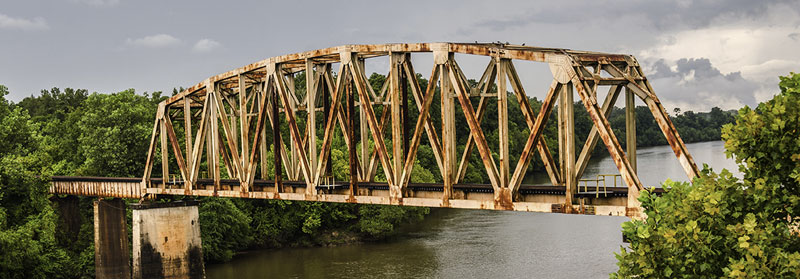A common misconception we encounter in the coatings industry is people thinking that we’re in the business of applying a fresh coat of paint on things just to make them a little easier on the eyes. Don’t get us wrong, that is certainly a part of what we’re trying to do. It was a big part of the job coating the new I-64 in St. Louis. The aesthetics of the coatings we apply can go a long way toward building community pride, like the Air Force logos we applied to two water towers on Scott Air Force Base in Illinois.

But broader concerns drive what we do here at Thomas Industrial Coatings. Some of those concerns surfaced in the President’s State of the Union address last month. Because we spend so much of our time getting up close and personal with the nation’s infrastructure, it is a problem we in the coatings industry know all too well.
More than one coat deep
As the New York Times recently reported, fully 70,000 bridges qualify as “structurally deficient” across the country. The website for the American Society of Civil Engineer’s 2013 Report Card for American Infrastructure boldly displays the nation’s infrastructure grade on the home page. It’s a D+, and it puts the estimated investment needed by 2020 at $3.6 trillion. The NACE Institute estimates that “unmitigated corrosion costs the U.S. economy over $500 billion each year, or roughly 3.1 percent of our GDP.”
While seldom in the headlines, corrosion and its effect on the country’s infrastructure is clearly a significant, and a significantly expensive, problem in the United States. It becomes even more significant when one considers how closely it’s tied to the overall state of the economy. Commerce can’t occur if the nation’s bridges sit in shambles and its ports are crumbling into the sea.
The jobs created by ambitious projects such as the Water Resources Reform and Development Act (WRRDA) and the Surface Transportation Reauthorization can’t be outsourced, like so many in manufacturing have been. This fact was the justification behind the American Recovery and Reinvestment Act of 2009, which provided a portion of the funds that put our crews on the Eads Bridge in St. Louis. Corrosion is a major problem, but in solving it we can create jobs for Americans, the thinking goes.
The good news is that under the care of qualified professionals, corrosion can be addressed with hugely successful results. Let’s be clear, 70,000 bridges across the country do not need to be replaced. Here at Thomas, we’ve prepped, abated, coated and fireproofed quite a few bridges that were getting up there in years. The services we perform on bridges like the Huey P. Long and Eads bridges will ensure that they continue to serve the public for years to come.
We’re obviously pretty passionate about this topic here at Thomas Industrial Coatings. If Don Thomas wasn’t, he probably wouldn’t have founded this company more than 20 years ago. But the passion runs deeper than a top-coat of paint. We care about coatings because we know that deep down they reflect the health of the country’s infrastructure, and by extension, its economy. That’s why we take real pride in every project we execute. That’s the real reason behind Thomas Pride.


